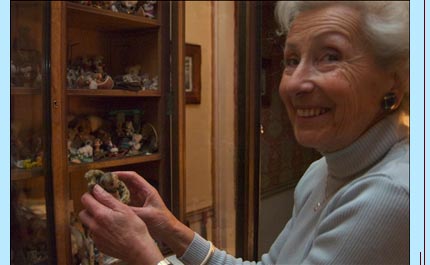Mrs. H.J. was born in April 1928. Today, this energetic and likable octogenarian is living a life worthy of competitive athletes. This is not because of her athletic performance in the stadium, but because she performs feats that very few people of her age can accomplish. In September 2006, she went on an 8 day mountain hike – in the Grand Paradise range in Italy – in the course of which she walked 6 hours a day over irregular terrain that had differences in level of 800 to 1000 meters. An impressive feat!
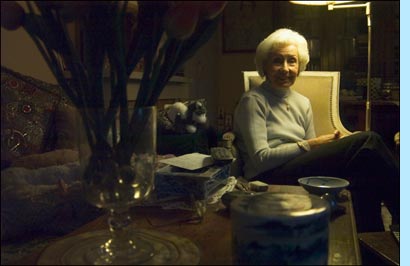
If you don't find this unusual, consider this: This former airline stewardess, who was an avid skier, skidded on an ice patch and broke her left femur (thigh bone) just below the hip. This was in March 1985. Mrs. H.J. was then 57 years old. A year later, on October 10, 1986, the orthopedic material was removed.
For those of you who remain unsurprised, here is an additional matter to consider: in January 1993 she fractured the same femur again while skiing. This time, the break occurred in the lower part of the femur, just above the knee. She was operated on immediately, but she did not recover well. The bone did not set, and on October 20, 1993, 9 months later, she was operated on a second time. A coral graft was performed, leaving the material in place. Within the next three months, the plate broke while she was walking with two canes and putting partial weight on her leg. The third surgical intervention, on January 25, 1994, involved removing the old material and replacing it with more durable material, without touching the graft. Mrs. H.J. was allowed to walk while placing partial weight on her leg after 6 weeks. Having entered the reeducation clinic on February 14, 1994, she left it six weeks later, on April 7, 1994. Later, Mrs. H.J. asked that the material, which was uncomfortable, be removed. The material was therefore removed on December 13, 1999. Thus, the femur was operated on 6 times, twice near the hip, four times near the knee. She also broke her right wrist, and the ninth rib on her left side in 1993.
The high number of fractures may seem surprising, but may be partly explained by the fact that after the death of her husband in 1982, Mrs. H.J. suffered severe health problems. Her uterus and two ovaries were removed in January 1983, when she was 55 years old. She is 1,60 m tall, and weighs 53,3 kg.
| HISTORY Mme H.J. was born on April 15, 1928 HYSTERECTOMY + OVARIECTOMIE in January1983 at the age of 55 |
|
| March 1985 | Subtrochanteric fracture of the left femur |
| March 1985 | Osteosynthesis with a screw plate (Pitie Salpetriere) |
| April 1986 | Removal of the material (Neuilly) |
| January 1992 | T.H.S. : ESTROGEN + PROGESTERONE |
| January 1993 | Supracondyle fracture of the left femur |
| January 1993 | Osteosynthesis with a screw plate (Gap) |
| August 1993 | Fracture of the 9th left rib |
| August 1993 | Fracture of the left wrist (Pouteau Colles) |
| October 1993 | Decortication + graft of natural coral + bone marrow (Courbevoie) |
| January 1994 | Fracture of the plate. Replaced with a blade plate (Courbevoie) |
| November 1999 | Removal of the material + coral graft + bone marrow (Paris) |
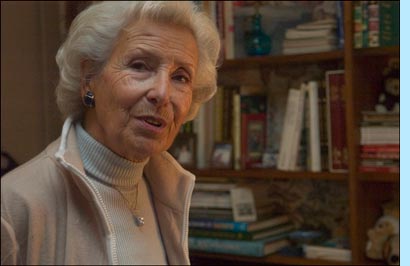
| FRACTURE OF THE LOWER THIRD OF THE LEFT FEMUR | |
 |
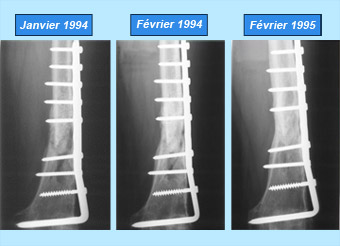 |
| Fracture of the femur in January 1993 |
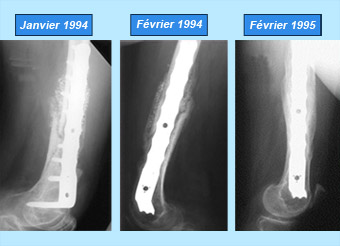 |
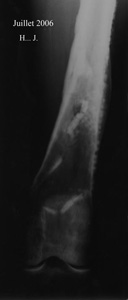 |
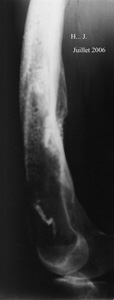 |
CLINICAL: • No pain |
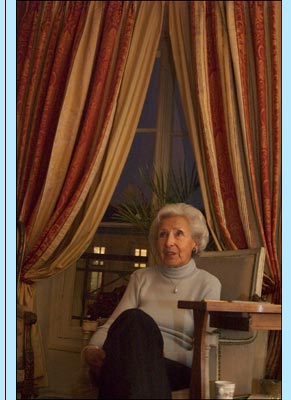
CONCLUSION
On the clinical level:
Mrs. H.J.'s health problems began in 1982, following the death of her husband. No one can deny the close relationship between the mind and the soma. She had a close loving relationship with her husband and no one will be surprised that her problems began in the genital area.
She underwent surgical castration a year later in 1983. The removal of the ovaries led to the disappearance of hormonal secretions. As we know, such a decrease has repercussions on bone metabolism. She broke her femur for the first time in 1985, three years after her husband's death.
Mrs. H.J. began substitute hormonal treatment in 1992.
The following year, she broke her wrist, a rib and her left femur (for the second time).
In 1993, the reconstruction of her femur was accompanied by a graft of natural coral.
From 1994 to this day, Mrs. H.J. has led a normal life, and has had a very active lifestyle for a person her age. She travels a lot and is planning a tour of central Europe.
On a biological level in2006 :
Phosphocalcic metabolism was normal.
- Secretion of intact parathormone was normal.
- The level of Vit D3 was normal.
- The report on biological bone markers showed that Mme H.J. had a physiological bone resorption and a bone formation that was above the normal limit
HYPOTHESES
The fundamental research to which we refer was done on healthy, not fractured, animal femurs; The densitometric measurements as well as the biological dosages were done on young adult men after a stay in MIR.
Our role is to treat and repair as best we can broken bones that have already lost a greater or lesser quantity of their bone mass because of age and/or osteoporosis. We must take into consideration the fact that the bone needs to get - from the site of the fracture (or other areas of bone) - enough calcium for the creation of a new callus and the mineralization of the bone crystal. We must also take into consideration the fact that there will be necessary new bone loss caused by being bedridden, as well as by the non use of the bone for the time it takes for a sufficient mechanical recovery.
It can sometimes take as long as five years for a healthy bone of a young adult in good physical condition to recover a structure identical to the structure it had before being subjected to micro gravity during space travel. How long then will it take for a bone belonging to an older person, that has already been subjected to mineral loss and has been broken, to recover its pre-fractured state?
In the course of the prospective multi centric randomized study, it was found that several fractures not treated with natural coral had not consolidated after one year.
We must therefore distinguish two stages in our analysis: the fracture of the demineralized bone on the one hand and the inability to bear weight on the other.
1° - How long does it take for an osteoporitic hip fracture to consolidate?
• We know that 80% of fractures treated with natural coral are consolidated within 3 months, as opposed to 50% of those which have not been treated with coral. Natural coral reduces consolidation time in a statistically significant manner when there has been a loss of bone mass
.
2°- We don't know, however, how long it takes for a fractured bone to recover its internal structure
• We can predict fairly confidently that it cannot take less time in an older person than it does in a young adult. We can also predict, without being grossly mistaken, that it must take longer for an osteoporotic femur than it does for a healthy femur (3). While it may not unduly impair a young person to not recover all of his or her skeletal capacity for a long period (sometimes for up to 5 years), it is not the case for a older person. Aren't the fear of breaking one's bone again, the fear of falling should one venture out, subconscious “warnings” about that long- term bone fragility ?
Bon Voyage !
| Picture Credits © Carole b. |
